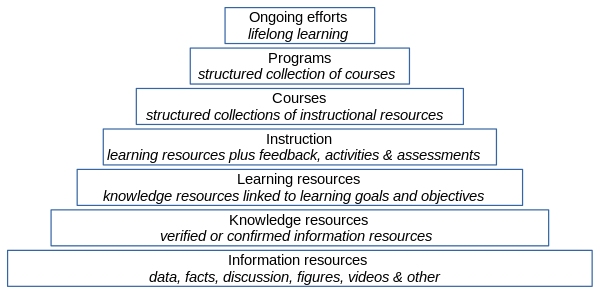Learning resource
 From EduTechWiki - Reading time: 2 min
From EduTechWiki - Reading time: 2 min
Introduction[edit | edit source]
A learning resource is an artifact that contributes to a learning process. Some authors restrict its meaning to content, others include tools and environments. We suggest making a distinction between resources and tools as in learning design methods, although boundaries overlap. E.g. a wiki is both a resource that contains contents and a tool allowing learners and teachers to write. An other example of non-standard learning resources are student productions that can be just outputs to be evaluated or objects that can be reused in a learning activity or even become resources for other learners. An other question concerns "built-in pedagogy". For some authors a resource refers to any kind of information material, for others it must be linked to learning goals and for still others it should include some kind of sequencing, see e.g. learning objects.
Rensing et al., in a technical report [1] define learning Resource as a digital resource used for E-Learning, sometimes tied to a given context. “This definition of Learning Resource covers small resources like media objects or single hypertext-like documents as well as bigger resources like complete courses or Web based Trainings. Learning Resources can consist of several documents, written in different formats, like SCORM Content Packages. The definition of Learning Resources differs from the definition of Learning Objects. A Learning Resource can be afflicted with context and does not have to be self-contained. From a practical perspective Learning Resources are bound to learning or teaching context in most of the times.”
The purpose of a leaning resource can change over time. Learning resources can be reused without modifications, with modification, with aggregation or with complete re-authoring. See also:
Spector et al. hierarchy of learning resources[edit | edit source]
Huang et al. define a hierarchy of learning materials and the learning resource corresponds to one specific element, i.e. materials linked to a learning goal. “Information that has been determined to be reliable and accurate can be considered knowledge and a candidate for inclusion among learning resources. When that knowledge is linked to a learning goal or objective, it can be considered a learning resource. When activities, feedback, and assessment are included with a learning resource, it becomes an instructional object or resource.” (Huang, Spector and Yang, 2019) [2]
The following figure capture the complexity of various types of materials in terms of a hierarchy that begins with information resources at the base of a pyramid and ends with "lifelong learning". Learning resources in the narrow sense are located in the middle.

Bibliography[edit | edit source]
- ↑ Christoph Rensing, Sonja Bergsträßer, Tomas Hildebrandt, Marek Meyer, Birgit Zimmermann, Andreas Faatz, Lasse Lehmann, Ralf Steinmetz (2005), Re-Use, Re-Authoring, and Re-Purposing of Learning Resources Definitions and Examples, Technische Universität Darmstadt, https://www.kom.tu-darmstadt.de/fileadmin/Externer_Bereich/Publications/Technical-Reports/technical-report-kom-2005-02.pdf
- ↑ Huang R., Spector J.M., Yang J. (2019) Introduction to Educational Technology. In: Educational Technology. Lecture Notes in Educational Technology. Springer, Singapore
 KSF
KSF